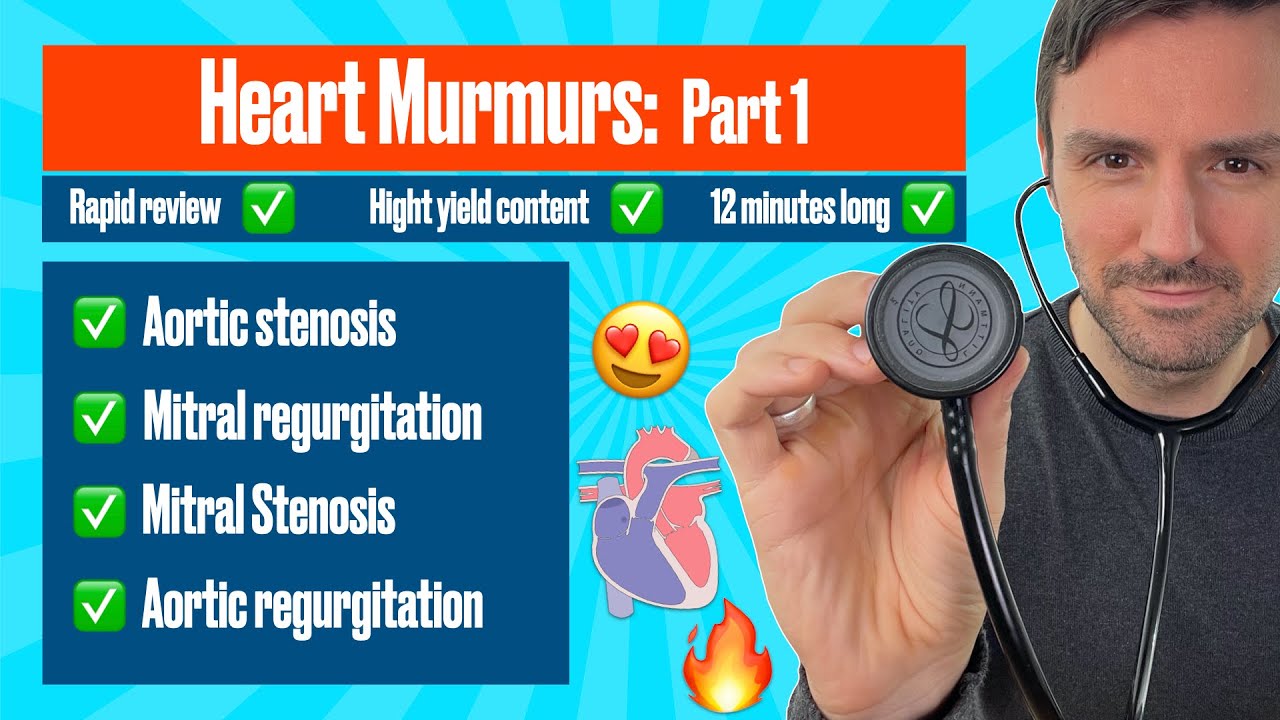Heart murmurs for beginners Part 2: Atrial septal defect, ventricular septal defect & PDA🔥🔥🔥🔥
Summary
TLDRIn this episode of Learn Medicine, Dr. Coleman reviews three types of heart murmurs: ejection systolic murmur in atrial septal defect, pan-systolic murmur in ventricular septal defect, and machinery murmur in patent ductus arteriosus. He explains the cardiac cycle, how turbulent blood flow creates audible murmurs, and the specific characteristics of each murmur. The video also covers the causes, symptoms, and clinical implications of these defects, helping viewers to identify and understand heart murmurs effectively.
Takeaways
- 👨⚕️ Dr. Coleman introduces the episode by reviewing three types of heart murmurs related to specific cardiac conditions.
- 🔍 The first murmur discussed is the ejection systolic murmur with a split S2, associated with atrial septal defect, characterized by turbulent blood flow during systole.
- 📊 The mnemonic 'lub-wooshh-dubba' is provided to help remember the sound of the atrial septal defect murmur.
- 💧 Atrial septal defects allow left-to-right shunting of blood, increasing the volume in the right atrium and ventricle, leading to the murmur.
- 👂 The ejection systolic murmur of atrial septal defect is best heard at the left upper sternal border and may radiate to the back.
- 🔊 The second murmur is the pansystolic murmur found in ventricular septal defect, which occurs throughout systole and is represented by a plateau wave.
- 🧬 Ventricular septal defects are common congenital heart diseases, sometimes associated with genetic factors and conditions like Down syndrome.
- 🚫 The loudness of the pansystolic murmur often masks the S1 and S2 heart sounds, making them difficult to hear.
- 🌀 The final murmur is the machinery murmur in patent ductus arteriosus, a continuous murmur throughout systole and diastole due to abnormal blood flow between the aorta and pulmonary artery.
- ⏳ Patent ductus arteriosus is a fetal structure that may fail to close after birth, leading to a continuous murmur, and is associated with prematurity and maternal infections.
- 📝 The machinery murmur of patent ductus arteriosus is loudest in the left infraclavicular area and may present with a systolic thrill and bounding pulses.
Q & A
What are the three types of heart murmurs discussed in the video?
-The three types of heart murmurs discussed are the ejection systolic murmur with a split S2 found in atrial septal defect, the pan-systolic murmur found in ventricular septal defect, and the machinery murmur found in patent ductus arteriosus.
What is the characteristic sound of an ejection systolic murmur in atrial septal defect?
-The ejection systolic murmur in atrial septal defect is a crescendo-decrescendo murmur, which can be remembered by the phrase 'lub-wooshh-dubba'.
How does the interatrial septum relate to atrial septal defects?
-The interatrial septum is a thin tissue that separates the left and right atria. Atrial septal defects occur in this tissue, allowing abnormal communication between the left and right atria.
What is the significance of the left-to-right shunt in atrial septal defects?
-The left-to-right shunt in atrial septal defects allows an increased volume of blood to enter the right atrium and subsequently the right ventricle, leading to turbulent blood flow and the characteristic murmur.
What are the typical symptoms of atrial septal defects in clinical history?
-Clinical history of atrial septal defects may include asymptomatic cases, dyspnea, faltering growth, and in later life, symptoms may occur by the age of 25 due to increased pulmonary pressures.
What is the visual representation of a pan-systolic murmur found in ventricular septal defects?
-A pan-systolic murmur is visually represented with a plateau wave, indicating that it occurs throughout the entire duration of systole.
How does the interventricular septum relate to ventricular septal defects?
-The interventricular septum is a thin membrane of tissue that separates the left and right ventricles. Ventricular septal defects occur in this septum, allowing abnormal communication between the ventricles.
What is the typical location to hear the murmur of ventricular septal defects?
-The murmur of ventricular septal defects is a pan-systolic murmur that is loudest at the left sternal edge.
What is the fetal structure that, if not closed after birth, can cause a patent ductus arteriosus?
-The ductus arteriosus is a fetal vascular structure that allows blood to bypass the lungs during fetal development. If it remains open after birth, it can cause a patent ductus arteriosus.
What is the characteristic sound of a patent ductus arteriosus?
-A patent ductus arteriosus produces a machinery murmur, which is a low-pitched, continuous burrrring sound throughout systole and diastole.
What are some risk factors for developing a patent ductus arteriosus?
-Risk factors for developing a patent ductus arteriosus include prematurity, maternal rubella infection during pregnancy, and female gender.
Outlines

Cette section est réservée aux utilisateurs payants. Améliorez votre compte pour accéder à cette section.
Améliorer maintenantMindmap

Cette section est réservée aux utilisateurs payants. Améliorez votre compte pour accéder à cette section.
Améliorer maintenantKeywords

Cette section est réservée aux utilisateurs payants. Améliorez votre compte pour accéder à cette section.
Améliorer maintenantHighlights

Cette section est réservée aux utilisateurs payants. Améliorez votre compte pour accéder à cette section.
Améliorer maintenantTranscripts

Cette section est réservée aux utilisateurs payants. Améliorez votre compte pour accéder à cette section.
Améliorer maintenantVoir Plus de Vidéos Connexes

Heart murmurs for beginners 🔥 🔥 🔥 Part 1:Aortic & Mitral stenosis, Aortic & mitral regurgitation.

Getting to the Root Cause of MS and Chronic Fatigue Syndrome

Monkeypox: A Laboratory Medicine Perspective

STRANGE MEDICINE - PEYOTE - OKLEVUEHA NATIVE AMERICAN CHURCH

An Introduction to Acupuncture - Episode 23 - Spotlight on Migraine

NEJM This Week — May 8, 2025
5.0 / 5 (0 votes)
